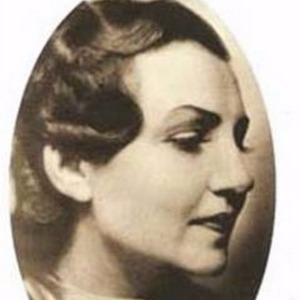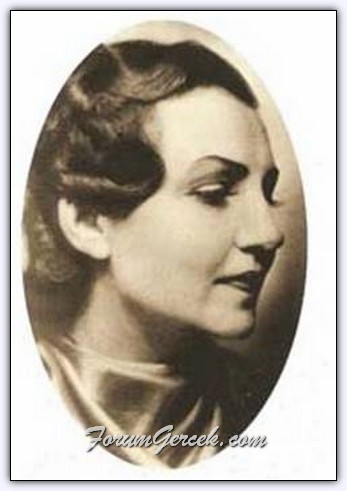
Painter (B. 1901, Istanbul
– D. 5 September 1991, Amman). Also known as Fahr El Nisa Zeid, Fahrunnisa Zeid and Fahrelnisa Zeid. She was born in Istanbul, Büyükada
at the manor house of her family. Her father was Kabaağaçlızade Mehmet Şakir Pasha,
a diplomat, soldier, and historian, her mother was Sare Ismet Hanım from Crete.
She was the sister of the gravure artist Aliye Berger and the Fisherman of Halicarnassus/Halikarnas
Balıkçısı (Cevat Şakir
Kabaağaçlı)- the writer, also the aunt of ceramist Füreya Koral, mother of painter Nejat Devrim
and theatre actress Şirin Devrim. The members of the Şakir Pasha Family, who
witnessed the late periods of the Ottoman Empire and early periods of the
Turkish Republic, have a justified reputation with their extraordinary lives
and artist identities. Fahrelnisa Hanım acquired her surname upon her marriage
with Prince Zeid, the ambassador of Iraq of the period and
brother of King Faisal the 1st.
Şakir Pasha, who
resented his elder brother’s banishment by Sultan Abdulhamid, has declined the
house at the Bosphorus offered by the Palace and has moved to Büyükada with his
family. Şakir Pasha, who was an Ottoman intellectual closely interested in the
photography and history, knowing many languages and has a macro word
perspective, prepared the convenient conditions for his children’s grow as
artists. Fahrelnisa Zeid, started her education in the primary school opened by
the art enthusiast Şakir Pasha. She completed her secondary education in Notre
Dame De Sion and Pansion Binagiotti. Meanwhile, Sare İsmet Hanım, who was said
to have attended the dergah at Fatih with her parents who were Rufiyan
dervishes, placed importance on her children’s learning the Orient cultures and
languages besides English, French, piano and painting lessons. She ensured they
took Persian, Arabic and Quran lessons.
Fahrelnisa Zeid started
painting by influence of her elder brother Cevat Şakir. At the age of eight, she
saw a painting made by his elder brother and started painting. Her elder
brother admired the paintings she made and advised her to continue painting.
The artist drew a watercolour portrait of her grandmother at the age of 14. The
artist, who started painting at 14 with this deep interest, became one of the
first female students of Sanayi-i Nefise Mektebi (Mimar Sinan Fine Arts University) during the
years of occupation (1920). Her starting
of higher education during the years of occupation resulted in continuing painting
training more seriously. Fahrelnisa Hanım married the author İzzet Melih Devrim
within the same year. Thanks to her marriage, she became acquainted with the
authors and intellectuals in Istanbul and Paris and her travels to various
European cities with İzzet Melih broadened her different horizons.
In 1928, Fahrelnisa Zeid
attended the atelier of Stalbach and Roger Bissiere at the Ranson Academy in
Paris. She worked with Namık İsmail at Istanbul Fine Arts Academy in 1920 and
1930. Fahrelnisa Hanım made her second marriage in 1934 with Emir Zeid el
Hüseyin, who was the Ankara representative of Jordan and the brother of
Jordan’s King Faysal the first. Upon her husband’s appointment to Germany as the
Iraq ambassador within the same year, she went to Berlin with him. Between 1935
and 1938, when she stayed in Berlin, she experienced a period engaged with the
German culture and art. The artist, who went to Baghdad in 1938 and stayed
there for a while, following a modern upbringing and the social environments she
entered in Europe, made paintings about Bedouin women in the closed world of the
east.
She had three children,
two from her first husband İzzet Melih Devrim called Nejat Devrim and Şirin
Devrim, and one from her second husband Emir Zeid, called Raad. The artist
returned to Istanbul in 1941 and joined the “D Group” in 1942. She was awarded
with the Royal Medal of Jordan in 1981, Italian Rispoli Medal in 1987 and
French "Commandeur des arts et des Letres" in 1987. Started from
1944, she held numerous private exhibitions in various countries of the world
and in Turkey and joined the group exhibitions. In France, where she was known
as an important painter of the modern style, she used the signature Fahrelnisa.
After his husband’s
death in 1970, Fahrelnisa Zeid moved in Amman in 1976, where her son Raad was
living. She established an arts institute called with her name in this city.
She concentrated on drawing portraits during her last years. She exhibited her works
for the last time in Istanbul in 1988 and in France and Germany in 1990. She
died in Amman and was laid to rest at Royal Cemetery of Amman El Raghadan
Palace.
REFERENCE: Celal Esat Arseven / Sanat Ansiklopedisi (5 cilt, 1953-54), Nurullah Berk - Hüseyin Gezer / 50 Yılın Türk Resim ve Heykeli (1973), Görsel Büyük Genel Kültür Ansiklopedisi (1984), Taha Toros / İlk Kadın Ressamlarımız (Türkçe-İngilizce, 1988), Sezer Tansuğ / Fahr El Nisa Zeid (1996) - Resim Sanatının Tarihi (1999), Meydan Larousse Ansiklopedisi (2003), Nüzhet İslimyeli / Suluboya Resim tarihi (2009), İhsan Işık / Ünlü Sanatçılar (Türkiye Ünlüleri Ansiklopedisi, C. 5, 2013) - Encyclopedia of Turkey’s Famous People (2013), Fahrelnissa Zeid neden Doodle oldu? Fahrelnissa Zeid kimdir? (milliyet.com.tr, 07.01.2019).
